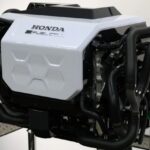Energy News Beat
As part of their collaborative effort to accelerate the advancement and fabrication of hydrogen fuel cell vehicles (HFCVs), Honda and GM founded the Fuel Cell System Manufacturing LLC (FCSM), a specialized plant for mass-producing HFC systems for their respective models.
By combining Honda’s fuel cell technology and GM’s manufacturing expertise, both corporations want to advance hydrogen fuel cell technology, cut expenses, and expand their manufacturing capacities to take advantage of economies of scale. In the long run, this partnership may lead to greater acceptance of hydrogen fuel cell vehicles by utilizing the advantages of each company.
Vehicles using hydrogen fuel cells run on an efficient and clean electrochemical method, as opposed to gasoline engines, which depend on combustion. They use hydrogen gas as fuel, and electricity is produced from hydrogen and oxygen through a sequence of events inside the fuel cell stack. Since the only consequence of this process is water vapor, hydrogen fuel cell cars represent a viable, low-emission, environmentally friendly mode of transportation.
Benefits of hydrogen fuel cell (HFC) technology
Transportation without emissions: HFCVs only emit water vapor as a byproduct, making them a more environmentally friendly option than conventional gasoline and electric cars, which depend on the creation of batteries and power.
Extended driving range: HFCVs have driving ranges that are on a level with gasoline-powered automobiles, which may allay worries about the constrained range that is sometimes connected to electric vehicles.
Quick refuel: Refueling a hydrogen car can be faster than charging an electric vehicle, potentially offering more convenience on long trips.
Honda’s new hydrogen vehicle
The Honda CR-V HFCV is a hydrogen fuel cell vehicle based on the popular Honda CR-V SUV. It has an estimated driving range of around 250 miles on a single fill of hydrogen, which is comparable to many gasoline-powered vehicles.
The 2024 CR-V has a tough exterior with a lengthy wheelbase and broad stance. This hydrogen fuel cell vehicle is equipped with features such as roof rails and a hands-free power tailgate, which make it suitable for a variety of adventures, whether you’re driving across town or the country.
Honda has designed an ideal cabin to explore the country. Thanks to a simple layout and wide sightlines, you will feel right at home as soon as you step in. A roomy cargo area, front seats with body-stabilizing technology, and a Bose premium sound system are among the interior features.
Additionally, there are many advancements in the CR-V, including responsive acceleration in both powertrains and elegant handling with available all-wheel drive (AWD). You can easily connect your smartphone with the available 9-inch touchscreen and wireless Apple CarPlay compatibility.
The CR-V FCEV is an amazing car, but perhaps its only drawback is the availability of hydrogen refueling stations is limited compared to traditional gas stations, which means that it can only be leased in California, where the hydrogen infrastructure is more developed.
The future of Honda and GM partnership
The association between Honda and GM is a major advancement for HFC technology. Nonetheless, additional work is required to solve issues, build out the hydrogen infrastructure, and increase customer interest in and accessibility of HFC vehicles.
While HFC technology is promising, challenges including low infrastructure for recharging, high production costs, and consumer range anxiety must be resolved if HFCV is to become more widely used. Therefore, Honda and GM should remain committed to further research and development of HFC technology to improve efficiency, reduce costs, and expand the range of HFCVs.
Furthermore, the joint venture investments between Honda and GM should concentrate on constructing a strong hydrogen refueling infrastructure, since this is essential for maintaining the feasibility and widespread integration of HFC automobiles.
The post Honda and GM have already said goodbye to electric cars: this is how they are preparing their new hydrogen beast appeared first on Energy News Beat.








